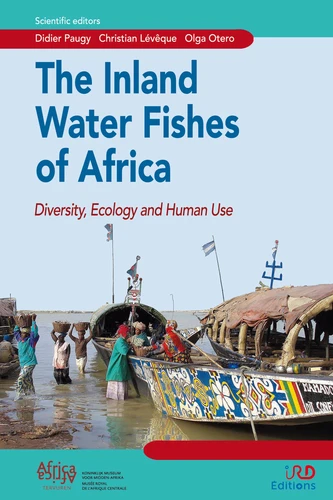The Inland Water Fishes of Africa : diversity, ecology and human use
Par : , ,Formats :
Disponible dans votre compte client Decitre ou Furet du Nord dès validation de votre commande. Le format Multi-format est :
- Pour les liseuses autres que Vivlio, vous devez utiliser le logiciel Adobe Digital Edition. Non compatible avec la lecture sur les liseuses Kindle, Remarkable et Sony
 , qui est-ce ?
, qui est-ce ?Notre partenaire de plateforme de lecture numérique où vous retrouverez l'ensemble de vos ebooks gratuitement
Pour en savoir plus sur nos ebooks, consultez notre aide en ligne ici
- Nombre de pages680
- FormatMulti-format
- ISBN978-2-7099-2401-6
- EAN9782709924016
- Date de parution27/11/2018
- Protection num.NC
- Infos supplémentairesMulti-format incluant ePub avec ...
- ÉditeurIRD Editions
Résumé
The equilibrium of inland hydrosystems is presently a cause for concern, with species extinction rates there estimated to be 5 times higher than for terrestrial fauna in the 21st century. Urgent measures must be taken to conserve these ecosystems particularly with regard to fishes, which represent an especially rich and diverse evolutionary heritage. Fishes were long unaffected by human activity on the African continent, but anthropogenic pressure has increased in recent decades.
Good management of African continental waters is thus of paramount importance in terms of heritage and economics, as fishes are a vital natural resource for the people in sub-Saharan Africa. In view of biodiversity conservation, African fishes are investigated here as a biological model owing to their enormous ecological and genetic diversity. It is essential to know the ecology and structure of various communities, and to understand the impact of human activity.
This book discusses the diversity of environments, the origin and evolution of species, survival and adaptive strategies, the structure of fish communities, and the impact of human activity. It also devotes a section to fisheries and fish culture. This ambitious project summarizes the current state of knowledge on African fishes and their populations, highlighting the mechanisms regulating their equilibrium and the causes contributing to their erosion.
It is a reference not just for readers involved in African aquatic environments, but for anyone interested in biodiversity conservation in general.
Good management of African continental waters is thus of paramount importance in terms of heritage and economics, as fishes are a vital natural resource for the people in sub-Saharan Africa. In view of biodiversity conservation, African fishes are investigated here as a biological model owing to their enormous ecological and genetic diversity. It is essential to know the ecology and structure of various communities, and to understand the impact of human activity.
This book discusses the diversity of environments, the origin and evolution of species, survival and adaptive strategies, the structure of fish communities, and the impact of human activity. It also devotes a section to fisheries and fish culture. This ambitious project summarizes the current state of knowledge on African fishes and their populations, highlighting the mechanisms regulating their equilibrium and the causes contributing to their erosion.
It is a reference not just for readers involved in African aquatic environments, but for anyone interested in biodiversity conservation in general.
The equilibrium of inland hydrosystems is presently a cause for concern, with species extinction rates there estimated to be 5 times higher than for terrestrial fauna in the 21st century. Urgent measures must be taken to conserve these ecosystems particularly with regard to fishes, which represent an especially rich and diverse evolutionary heritage. Fishes were long unaffected by human activity on the African continent, but anthropogenic pressure has increased in recent decades.
Good management of African continental waters is thus of paramount importance in terms of heritage and economics, as fishes are a vital natural resource for the people in sub-Saharan Africa. In view of biodiversity conservation, African fishes are investigated here as a biological model owing to their enormous ecological and genetic diversity. It is essential to know the ecology and structure of various communities, and to understand the impact of human activity.
This book discusses the diversity of environments, the origin and evolution of species, survival and adaptive strategies, the structure of fish communities, and the impact of human activity. It also devotes a section to fisheries and fish culture. This ambitious project summarizes the current state of knowledge on African fishes and their populations, highlighting the mechanisms regulating their equilibrium and the causes contributing to their erosion.
It is a reference not just for readers involved in African aquatic environments, but for anyone interested in biodiversity conservation in general.
Good management of African continental waters is thus of paramount importance in terms of heritage and economics, as fishes are a vital natural resource for the people in sub-Saharan Africa. In view of biodiversity conservation, African fishes are investigated here as a biological model owing to their enormous ecological and genetic diversity. It is essential to know the ecology and structure of various communities, and to understand the impact of human activity.
This book discusses the diversity of environments, the origin and evolution of species, survival and adaptive strategies, the structure of fish communities, and the impact of human activity. It also devotes a section to fisheries and fish culture. This ambitious project summarizes the current state of knowledge on African fishes and their populations, highlighting the mechanisms regulating their equilibrium and the causes contributing to their erosion.
It is a reference not just for readers involved in African aquatic environments, but for anyone interested in biodiversity conservation in general.







